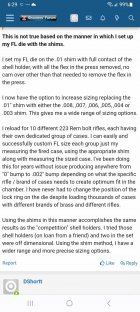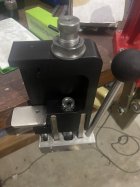Here is a little story that may increase the understanding of some who have posted here. Going on 30 years back I had a .220 Swift and a RCBS, one piece FL sizing die. The chamber was in a factory Savage barrel, and I have it on good authority that those dies were made to size down to SAAMI minimum spec. for loaded ammunition. In other words they changed the diameter of a fired case quite a lot, which requires more effort than one that is a close fit to a chamber. When I first set up the die, I raised the ram of my Rock Chucker to the top of its stroke and screwed the die down until it touched the shell holder, and tightened the lock ring. Then I lubed a case and ran it fully into the die, and noticed something. There was now a gap between the die and the shell holder. Curious, I got out my set of automotive feeler gauges and found the one that fit the gap. It was .006. Thinking about it for a minute, it became obvious that this was caused by linkage stretch, and that if I needed it, I had an additional .006 of down die adjustment to work with. This is why you can gain some sizing when adjusting a die, a little more toward the shell holder when it was initally set up to touch the shell holder with no case in place.....linkage stretch, or in some cases compression.
On the Skips shims, If you do an initial die setup with a .010 shim under the lock ring, and you need to change the die setting because of additional spring back from the brass becoming work hardened from repeated firings and sizing. All you have to do is to substitute a .009 shim, check the result, and if the bump is not happening or is not enough, substitute the .008 shim and so on. The initial setup with the .010 shim should be done just as if it was not there. What the shims do is give you the ability to easily make PRECISE adjustments by substituting progressively thinner shims. Doing this freehand is more difficult because of how little the die is turned to make a .001 adjustment. For those who have not done the calculation (1 divided by 14) one full turn moves the die .071".













